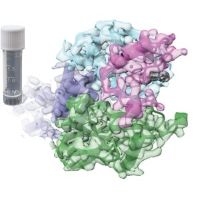Specification
| Description | Recombinant protein from the full-length sequence of Homo sapiens inositol-tetrakisphosphate 1-kinase (ITPK1), transcript variant 1 (NM_014216). |
| Organism | Homo sapiens (Human) |
| Expression Host | Human Cells |
| Tag Info | His or DYKDDDDK. Please contact us if you need further information or require specific designed tag. |
| Purity | Greater than 90% by SDS-PAGE gel |
| Uniprot ID | Q13572 |
| Entry Name | ITPK1_HUMAN |
| Gene Names | ITPK1 |
| Alternative Gene Names | |
| Alternative Protein Names | Inositol-tetrakisphosphate 1-kinase (EC 2.7.1.134) (Inositol 1,3,4-trisphosphate 5/6-kinase) (Inositol-triphosphate 5/6-kinase) (Ins(1,3,4)P(3) 5/6-kinase) (EC 2.7.1.159) |
| Application | Antigens, Western, ELISA and other in vitro binding or in vivo functional assays, and protein-protein interaction studies; For research & development use only! |
| Buffer | Purified protein formulated in a sterile solution of PBS buffer, pH7.2, without any preservatives |
| Endotoxin | Endotoxin level is < 0.1 ng/µg of protein (<1EU /µg) |
| Length | 414 |
| Molecular Weight(Da) | 45621 |
| Protein Sequence | (The sequence of expressed protein may have some variation from the sequence shown below. Please contact us for the exact sequence.) MQTFLKGKRVGYWLSEKKIKKLNFQAFAELCRKRGMEVVQLNLSRPIEEQGPLDVIIHKLTDVILEADQNDSQSLELVHRFQEYIDAHPETIVLDPLPAIRTLLDRSKSYELIRKIEAYMEDDRICSPPFMELTSLCGDDTMRLLEKNGLTFPFICKTRVAHGTNSHEMAIVFNQEGLNAIQPPCVVQNFINHNAVLYKVFVVGESYTVVQRPSLKNFSAGTSDRESIFFNSHNVSKPESSSVLTELDKIEGVFERPSDEVIRELSRALRQALGVSLFGIDIIINNQTGQHAVIDINAFPGYEGVSEFFTDLLNHIATVLQGQSTAMAATGDVALLRHSKLLAEPAGGLVGERTCSASPGCCGSMMGQDAPWKAEADAGGTAKLPHQRLGCNAGVSPSFQQHCVASLATKASSQ |
Background
| Function | FUNCTION: Kinase that can phosphorylate various inositol polyphosphate such as Ins(3,4,5,6)P4 or Ins(1,3,4)P3. Phosphorylates Ins(3,4,5,6)P4 at position 1 to form Ins(1,3,4,5,6)P5. This reaction is thought to have regulatory importance, since Ins(3,4,5,6)P4 is an inhibitor of plasma membrane Ca(2+)-activated Cl(-) channels, while Ins(1,3,4,5,6)P5 is not. Also phosphorylates Ins(1,3,4)P3 on O-5 and O-6 to form Ins(1,3,4,6)P4, an essential molecule in the hexakisphosphate (InsP6) pathway. Also acts as an inositol polyphosphate phosphatase that dephosphorylate Ins(1,3,4,5)P4 and Ins(1,3,4,6)P4 to Ins(1,3,4)P3, and Ins(1,3,4,5,6)P5 to Ins(3,4,5,6)P4. May also act as an isomerase that interconverts the inositol tetrakisphosphate isomers Ins(1,3,4,5)P4 and Ins(1,3,4,6)P4 in the presence of ADP and magnesium. Probably acts as the rate-limiting enzyme of the InsP6 pathway. Modifies TNF-alpha-induced apoptosis by interfering with the activation of TNFRSF1A-associated death domain (PubMed:11909533, PubMed:12925536, PubMed:17616525). Plays an important role in MLKL-mediated necroptosis. Produces highly phosphorylated inositol phosphates such as inositolhexakisphosphate (InsP6) which bind to MLKL mediating the release of an N-terminal auto-inhibitory region leading to its activation. Essential for activated phospho-MLKL to oligomerize and localize to the cell membrane during necroptosis (PubMed:17616525). {ECO:0000269|PubMed:11909533, ECO:0000269|PubMed:12925536, ECO:0000269|PubMed:17616525}. |
| Pathway | |
| Protein Families | ITPK1 family |
| Tissue Specificity | Expressed in brain > heart > skeletal muscle = kidney = pancreas = liver = placenta > lung. In brain, it is expressed in cerebellum, cerebral cortex, medulla, spinal cord, occipital lobe, frontal lobe, temporal lobe and putamen. {ECO:0000269|PubMed:8662638}. |
QC Data
| Note | Please contact us for QC Data |
| Product Image (Reference Only) |  |

